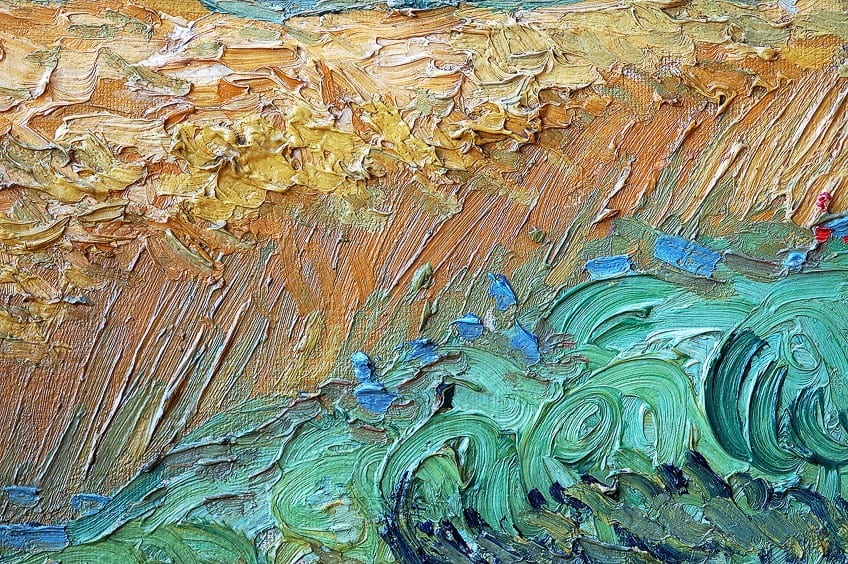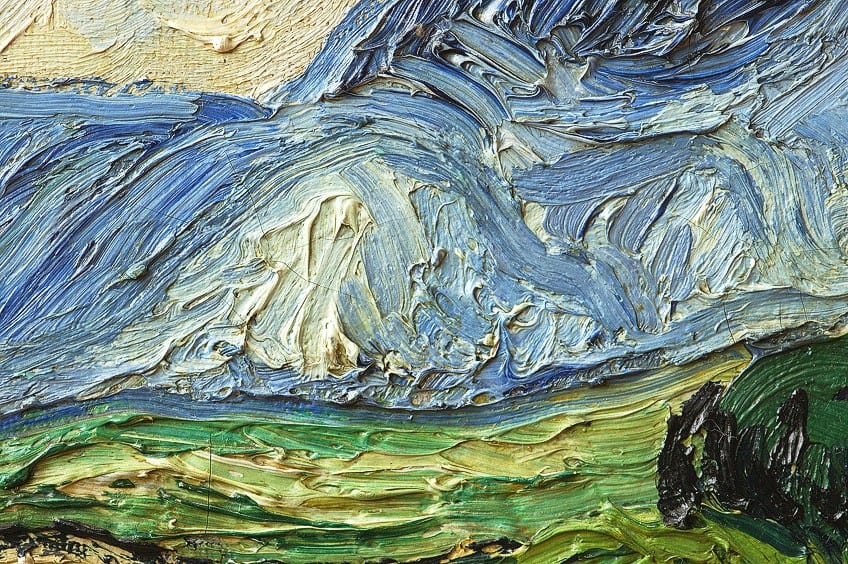“Wheat Field with Cypresses” by Vincent van Gogh – A Quick Look
The Wheat Field with Cypresses (1889) by Vincent van Gogh is one of his many landscape and scenic paintings depicting his love of not only nature, but his beautiful expression through each and every brushstroke. This is the painting we will discuss in the article below.
Artist Abstract: Who Was Vincent van Gogh?
Vincent van Gogh was a Post-Impressionist artist who lived from March 30, 1853, to July 29, 1890. He was around 27 years old when he started pursuing his art career, but he was also involved in various other disciplines throughout his life including art dealership, preaching, teaching, as well as being a missionary.

Van Gogh was religious and lived in various states of hardship his entire life, supported largely by his brother Theo van Gogh. He had ardent visions for his and his art colleagues’ lives and he is a popular artistic figure, made famous by the incident when he partly cut his ear.
Some of his famous artworks include “The Potato Eaters” (1885), “Bedroom in Arles” (1888), and “The Starry Night” (1889).
Wheat Field with Cypresses (1889) by Vincent van Gogh in Context
| Artist | Vincent van Gogh |
| Date Painted | 1889 |
| Medium | Oil on canvas |
| Genre | Landscape painting |
| Period / Movement | Post-Impressionism |
| Dimensions (cm) | 73.2 x 93.4 |
| Series / Versions | Wheat Field Series |
| Where Is It Housed? | Metropolitan Museum of Art, New York City, United States |
| What Is It Worth? | Sold by Dieter Bührle for $57 million to Walter Annenberg, who donated it to the Metropolitan Museum of Art in 1993 |
In the contextual analysis below, we will discuss a brief overview of where Vincent van Gogh was when he created his famous Wheat Field painting, as well as a formal analysis outlining the subject matter and his artistic style. It is important to note that this article will discuss the Wheat Field painting presented in the Metropolitan Museum of Art in New York City.
Contextual Analysis: A Brief Socio-Historical Overview
When Vincent van Gogh painted Wheat Field with Cypresses in 1889, he was living at the Saint-Paul-de-Mausole asylum, which is in Saint-Rémy-de-Provence in France. He was admitted, of his own accord, from May 1889 to May 1890.

During his stay, he was greatly inspired by the natural environment and the asylum’s garden around him and would often paint the landscape that consisted of cypress trees, and wheat fields, as well as renditions of the almond trees and the asylum grounds around him.
The Wheat Field Painting Versions
Van Gogh reportedly created four versions, varying in size, of the Wheat Field with Cypresses painting, namely, the version this article will focus on, which is housed at the Metropolitan Museum of Art in New York City, and was painted around early July 1889.

The other three versions are a reed-pen drawing, painted around June/July 1889, which is now housed at the Van Gogh Museum in Amsterdam. The other is part of a private collection, which he reportedly painted around September 1889, and the last one is at the National Gallery in London, which Van Gogh also painted around September 1889.
Formal Analysis: A Brief Compositional Overview
Vincent van Gogh has lovingly been known for his use of expressive brushstrokes and unique color schemes. These have made his art characteristically his own. The formal analysis below will discuss a visual description of the Wheat Field painting and how Van Gogh painted it, which we will outline according to the art elements and principles.

Subject Matter: Visual Description
Wheat Field with Cypresses by Vincent van Gogh depicts a golden field of wheat in the foreground. In the direct foreground, to the lower right, is a patch of green grass and flowers, and what appears to be the top of a rock just making its way into our (the viewers’) space in the center.
Along the middle ground are what appears to be an olive tree to the left and the cypress trees to the right edge of the composition, one of which reaches seemingly all the way into the heavens above.

The background is composed of a landscape that opens to what appears to be mountains in the distance, however, these appear to conjoin with the swirling clouds in the sky above, the latter composing almost two-thirds of the canvas.
Color
Vincent van Gogh’s Wheat Field painting consists mostly of greens, yellows, and blues, and more specifically, he reportedly utilized a zinc white paint. Color contrast is also created by the temperatures and brilliance of the hues.
For example, the cool blues of the sky above contrast the warmer yellows of the wheat field below.

Additionally, the cooler, and darker green hues of the cypress trees and the lighter green of the other trees that all compose the middle ground create a distinctive band across the composition, seemingly separating the upper and lower parts.
Texture
As with almost all of Vincent van Gogh’s landscape paintings, he created a world of textures, and oftentimes it would not be to replicate what we see in nature but to convey deeper meanings and emotions. For example, the paint for the sky and clouds are applied in thick curling strokes and dabs, all of which create the impression of a dynamic cloudy sky.
The linear, diagonal, and short brushstrokes of the wheat in the field, also thick and thin areas of paint, below all create a sense of movement and rhythm as if the wind is blowing through them.

Line
There are a variety of lines in Wheat Field with Cypresses by Vincent van Gogh, some of these include diagonal, curving, curling, short, and long, which are all created by how Van Gogh applied his brushstrokes. Additionally, there is also an interplay of vertical and horizontal lines implied by the natural environment.
For example, the horizontal orientation of the landscape itself is contrasted by the vertical line created by the tall cypress tree to the right, which also adds emphasis to the subject matter.

Shape and Form
As with the lines mentioned above, there are also a variety of shapes and forms in Vincent Van Gogh’s Wheat Field painting. Shape as an art element relates more to two dimensions whereas forms are more three-dimensional, and so we see shapes created by Van Gogh’s brushstrokes that delineate the subject matter, notably round shapes like the clouds in the sky or some of the bushes in the middle ground.

The forms are organic, in other words, they originate in nature, and although Van Gogh’s composition appears expressive, we (the viewers) are still able to ascertain that this is a natural outdoor scene, an example includes the conical form of the cypress trees.
Space
The compositional space can be viewed as if in threes, for example, the foreground depicts the wheat field, which is the lower portion of the composition, the middle ground opens into the distance and the sky fills most of the upper portion of the canvas, as mentioned above.
The clouds and variation of colors and lines create a sense of three-dimensionality between the land and the sky.

Van Gogh’s Vast World
While the world of Vincent van Gogh is vast and his artworks remain some of the most beloved visual encounters for art lovers, we have just touched on some of the main aspects of his painting Wheat Field with Cypresses, which is at the Metropolitan Museum of Art in New York City.

We discussed when Van Gogh painted it and that it was part of a larger body of work depicting wheat fields when he was a patient at a mental institution in France, including what the subject matter consists of, as well as a formal analysis of his artistic style outlined by the elements of art.
The “Wheat Fields” painting is seemingly pure movement on canvas. Van Gogh painted the world around him but infused it with his own sight and sense of something more, which we are somehow privy to when we look at each twirl and whirl of brushstroke laden with the texture of his paint. Everything in this “Wheat Field” painting moves together in a rhythm that undoubtedly moved through Van Gogh, spilling onto his canvas.
Frequently Asked Questions
Who Made the Wheat Field Painting?
The Post-Impressionist Vincent van Gogh painted the Wheat Field with Cypresses (1889). It was painted when Van Gogh was living at a mental institution in Saint-Rémy in France, which is also where he was inspired by the natural environment around him.
Is the Wheat Field Painting Part of a Series?
Wheat Field with Cypresses (1889) by Vincent van Gogh is part of a series of other wheat field paintings called the Wheat Field Series. Van Gogh reportedly created four Wheat Fields works depicting Cypress trees, which are housed at the National Gallery in London, the Metropolitan Museum of Art in New York City, and as part of a private collection. The last artwork in his Wheat Fields series was a drawing, which is housed at the Van Gogh Museum in Amsterdam.
Where Is the Wheat Field with Cypresses by Vincent van Gogh?
The Wheat Field with Cypresses (1889), which was reportedly painted in July of 1889, is currently housed at the Metropolitan Museum of Art in New York City. The painting was donated to the museum in 1993 by Dieter Bührle.
Alicia du Plessis is a multidisciplinary writer. She completed her Bachelor of Arts degree, majoring in Art History and Classical Civilization, as well as two Honors, namely, in Art History and Education and Development, at the University of KwaZulu-Natal, South Africa. For her main Honors project in Art History, she explored perceptions of the San Bushmen’s identity and the concept of the “Other”. She has also looked at the use of photography in art and how it has been used to portray people’s lives.
Alicia’s other areas of interest in Art History include the process of writing about Art History and how to analyze paintings. Some of her favorite art movements include Impressionism and German Expressionism. She is yet to complete her Masters in Art History (she would like to do this abroad in Europe) having given it some time to first develop more professional experience with the interest to one day lecture it too.
Alicia has been working for artincontext.com since 2021 as an author and art history expert. She has specialized in painting analysis and is covering most of our painting analysis.
Learn more about Alicia du Plessis and the Art in Context Team.
Cite this Article
Alicia, du Plessis, ““Wheat Field with Cypresses” by Vincent van Gogh – A Quick Look.” Art in Context. April 3, 2023. URL: https://artincontext.org/wheat-field-with-cypresses-by-vincent-van-gogh/
du Plessis, A. (2023, 3 April). “Wheat Field with Cypresses” by Vincent van Gogh – A Quick Look. Art in Context. https://artincontext.org/wheat-field-with-cypresses-by-vincent-van-gogh/
du Plessis, Alicia. ““Wheat Field with Cypresses” by Vincent van Gogh – A Quick Look.” Art in Context, April 3, 2023. https://artincontext.org/wheat-field-with-cypresses-by-vincent-van-gogh/.











